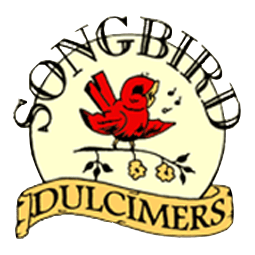March 29, 2023
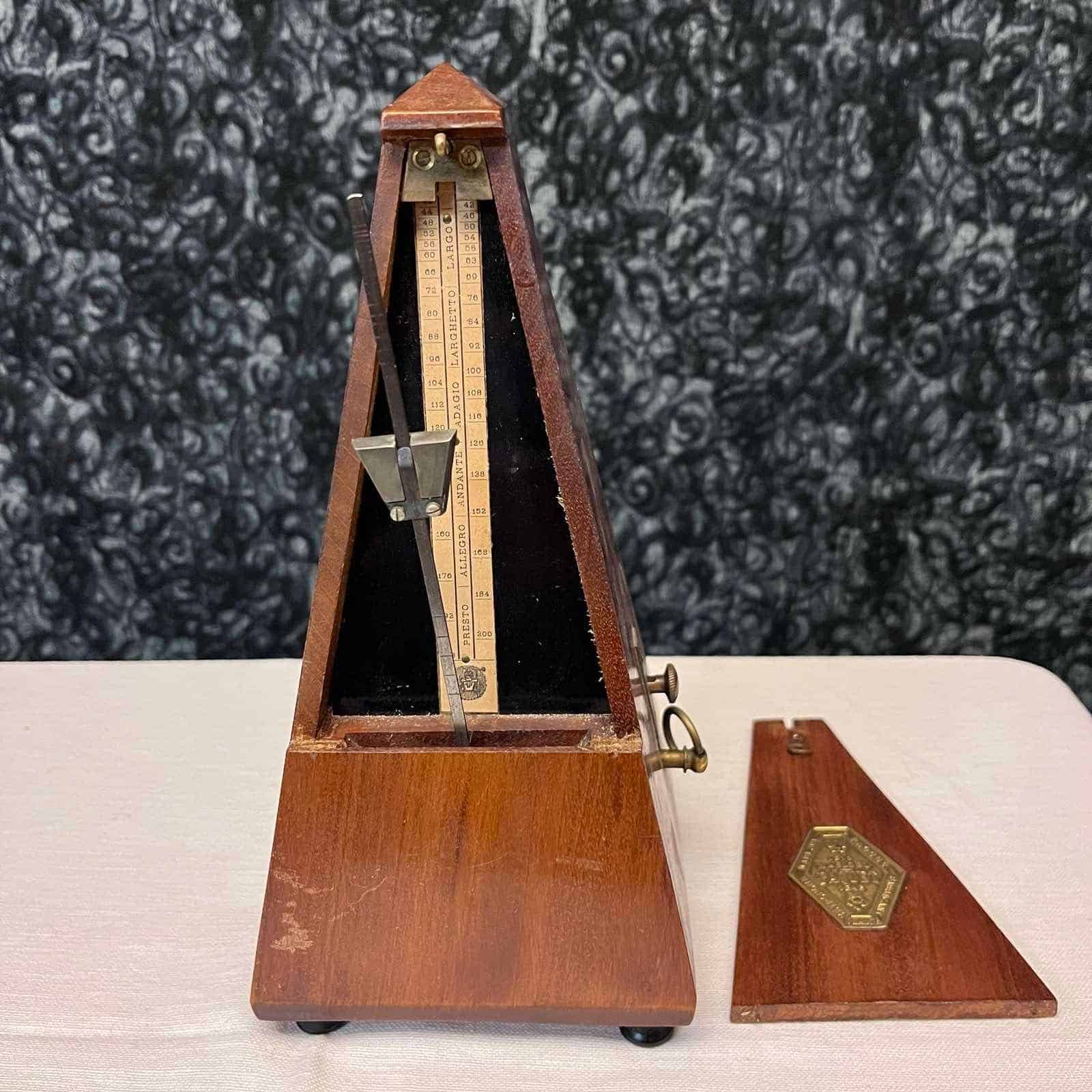
By Nicolette Foss
Rhythm and timing are especially important for percussion instruments like the hammered dulcimer. Other musicians often tend to follow the rhythm that we are playing. But if you find that you are often playing too fast or too slow, you can lead the whole jam astray! That is why metronome practice is especially important for us hammered dulcimer players..
But you’re not alone. Even the most experienced player still benefits from using a metronome (like Ted Yoder)! In this article, we will introduce you to the metronome, why using one can drastically improve your playing, and how to use it when playing the hammered dulcimer.
What is a Metronome?
A metronome is a tool used by musicians to play rhythms accurately. The metronome emits a steady-sounding pulse (aka the beat). These sounds guide the hammered dulcimer player to strike the strings at the right tempo, or speed at which the song is played.
There are varying types of metronomes including:
- Mechanical: This is the classic metronome that is in a rhombus shape and makes a loud clicking sound to denote the beat. The mechanical metronome has an adjustable weight attached to the end of an inverted pendulum. The weight can be slid up the pendulum to decrease the desired tempo or slid down to increase the tempo.
- Quartz: Quartz metronomes are an inexpensive alternative to mechanical ones. They use blinking lights and auditory cues to signal the beat. The tempo is adjusted by cranking the dial or pressing buttons.
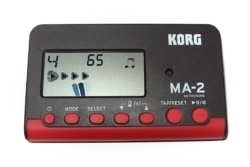
Korg MA-2 digital metronome Image from Multicherry, CC BY-SA 4.0, via Wikimedia Commons
- Digital: Probably the most used today, digital metronomes often come with many customization options. Variations of digital metronomes include handheld, downloadable, phone apps, or software.
To pick out the right metronome for you and your hammered dulcimer, there are several things to consider. If you don’t already have a tuner, you could get an all-in-one metronome/tuner. And if you happen to play a lot on the go, consider getting a smaller digital metronome or a phone app metronome rather than a large mechanical metronome.
However, if you find that visual cues help you, the swinging pendulum of a mechanical metronome may be helpful. Additionally, the flashing lights of the quartz metronome can be a cheaper alternative. You may also be able to find a digital metronome that can add visual cues.
Benefits of practicing with a metronome
You are probably wondering “But why is it important to use a metronome for hammered dulcimer?” Well, here are some very helpful benefits of consistent metronome practice:
- Improves timing: Metronomes help musicians play at the right speed. The more you practice with a metronome, the more skilled you will become with natural timing while playing the hammered dulcimer.
- Gives you a clear goal: If you aren’t playing in time to the tempo, the metronome will show you exactly where you are going wrong. This can be helpful in the beginning stages of learning to play because it gives you an identifiable goal to start to work toward and improve.
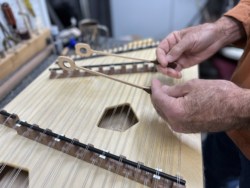
- Helps you build speed: If you want to eventually play fast, you must gradually build your playing speed. The best way to do this is to slowly start synchronizing the physical movements with the sounds of the metronome. Find a slower tempo for the song you are working on and repeat, repeat, repeat till you have it down. Then gradually build your speed to the tempo at which the song is meant to be played. You will find yourself developing greater technique when you start slow because you are learning to accurately train your muscle movements. As a result, when you do play fast, you will make fewer mistakes due to programmed muscle memory.
- Prevents “rushing” or “dragging”: “Rushing” happens when you hit the notes too early, which speeds up the beat. “Dragging” is when you are hitting the notes too late, which causes the beat to slow down. Since these phenomena can happen so gradually that you probably don’t even notice it, using a metronome will help you pinpoint exactly where you’re coming in too early or too late.
Measuring the Tempo
There are fast tempos, medium tempos, and slow tempos. But what is a quantitative way to measure tempo? That would be by Beats per Minute (BPM). BPM is exactly what it sounds like: how many beats occur in the song during one minute’s time. Most metronomes can do anywhere between 35 and 250 BPM.
The metronome is set in BPM and produces a click or sound at the right interval. For instance, if the music says 78 BPM, you would set the metronome to 78. Then it will click 78 times in one minute. The clicks tell you where the beat is located, and you can then sing and/or play along.
How to find the BPM?
Before you program your metronome, you will need to know the BPM. Here are a few ways to find the BPM:
Count the beats: To find the BPM of a song, you just need to know how to count! If you don’t want to count the beats in one minute, you can simply count the beats in 15 seconds of the music. Once you have that number, multiply by 4 and you will have the BPM of the song! Easy!
Italian tempos: Some musical scores, especially classical ones, will have Italian instructions on how fast or slow to play the song. These terms can refer to the whole piece of music or even just a section within the piece. Here is an example of Italian tempo instructions in a piece of music:

These terms are often used within contemporary music circles, so it can be helpful to know them. Be aware that the BPMs are just suggestions as are not specified timing rules. Not only do these terms refer to the pace the music is played, but sometimes with what feeling it is meant be played. Here they are from slowest to fastest:
- Larghissimo: Extremely slow–24 BPM and lower
- Adagissimo: Very slow–24 to 40 BPM
- Grave: Very slow and solemn–24 to 40 BPM
- Largo: Slow and broad–40 to 66 BPM
- Adagio: Slow with great expression–44 to 68 BPM
- Larghetto: Rather slow and broad–44 to 66 BPM
- Adagietto: Slower than andante or slightly faster than adagio—46 to 80 BPM
- Lento: Slow–52 to 108 BPM
- Andante: At a walking pace, moderately slow–56 to 108 BPM
- Andantino: Slightly faster than andante, but slower than moderato—80 to 108 BPM
- Marcia moderato: Moderately, at a marching pace–66 to 80 BPM
- Andante moderato: Between andante and moderato—66 to 112 BPM
- Moderato: At a moderate speed–86 to 126 BPM
- Allegretto: Moderately fast–76 to 120 BPM
- Allegro moderato: Close to allegro, but not quite–96 to 120 BPM
- Allegro: Fast and cheery–100 to 156 BPM
- Molto Allegro or Allegro vivace: Very fast and cheery–124 to 160 BPM
- Vivace: Lively and fast–136 to 160 BPM
- Vivacissimo: Very fast and lively–160 to 184 BPM
- Allegrissimo: Very fast and cheery–160 to 184 BPM
- Presto: Very fast–168 to 200 BPM
- Prestissimo: Extremely fast–200 bpm and over
Tap the tempo: You can now use an app or website to tap the BPM. Apps like Tap That Tempo (iOS) and BPM Tap (Android) allow you to tap the beat and it will tell you what BPM you’ve tapped. If you don’t have any room for an extra app on your phone, try this simple website instead: BPM Counter.
Software programs: DJ software programs like BPM Studio can find the beats-per-minute of a recorded audio file. Just upload the song and it will use its BPM counter function to tell you the BPM. Additionally, Digital audio workstation (DAW) software like Virtual DJ can calculate beats per minute. After determining the tempo of your audio file, it can create a click track you can use to record other tracks.
Websites: Like most things these days, you can find a song’s BPM by Googling it! Either Google the song name and BPM, or check out GetSongbpm or SongBPM. You can easily find millions of songs’ BPMs on these sites. That takes out the guesswork!
How to Use a Metronome When Playing the Hammered Dulcimer
Now that you’ve gotten your metronome in hand and the beats-per-minute, we will walk you through how to use a metronome. But as you open your metronome app, you may see an option to choose from different time signatures. You may be wondering if you need to use these numbers, and how they relate to BPM.
Time signatures
The BPM tells you how fast to play the song, while the time signature tells you how many beats are in a measure. The top number of the time signature means how many beats per measure, while the bottom number signifies which note gets the beat (half note, quarter note, etc.). Time signatures are used more for notational purposes, so do not worry too much about this if you do not read music.
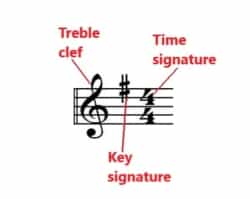
However, utilizing the time signature feature on your metronome will allow you to input how often you want the intervals to click. Here are some units of measure that you can choose each metronome click to represent:
- Quarter notes: Typically musicians will have the metronome set to one click per quarter note. This means if your music has a time signature denoting 4/4 time, each click can represent one quarter note and four of those clicks will equal a full measure. But if the time signature was 5/4, there will be five clicks per measure.
- Eighth notes: Some musicians will have the clicks of the metronome equal to eighth notes. So this means if the time signature was 6/8 for instance, 6 clicks would represent eighth notes, which would be one full measure.
- Dotted quarter notes: If the clicking is a little overwhelming, you can instead subdivide the time signature to dotted quarter notes on the metronome. So if the time signature was 6/8 like in the previous example, this could represent not only six eighth notes but also two dotted quarter notes. This means you will instead hear two clicks per measure rather than six clicks.
Playing hammered dulcimer using a metronome
Ready for metronome practice? It is time to play.
- Make sure you are familiar with the notes of the song first. You don’t want to be making a ton of mistakes when you are trying to focus on getting your rhythm right. Practice the song without worrying about your timing too much. After you’ve gotten that down, you are ready to practice with the metronome to perfect your rhythm.
- Turn up the volume on your metronome to ensure you will clearly be able to hear it over the sounds of your dulcimer. It is helpful to either place or clip your metronome right in front of or on your instrument. This ensures that the sounds/visual cues are all coming from the same direction as the music, and this can help reduce distraction.

This is a Seiko digital metronome (DM50) and can clip onto your dulcimer
- It can be helpful to first listen to the metronome before you play. Tap your foot to the beat and/or watch the visual cues to get a feel for the rhythm. Or try counting out the beats of each measure. For example, a song with ¾ time would go “1-2-3, 1-2,3” and so on.
- Once you start to flow with the beat of the metronome, start by practicing slowly. We recommend anywhere from 60 to 80 BPM. Again, practicing slowly will make for fast playing because you are programming your muscle memory. Play and/or sing along to the beat of the metronome.
- When you have trouble with certain parts, spend some time working on them individually. Focus on the difficulties by adding notes one at a time. Play the single note. Then play the note again, along with the second note. Then play the first two notes, along with the third one. Keep going till you get through the troublesome part of the music.
- It can also be helpful to focus on playing with each hand alone to strengthen your weaker hand. Sometimes our timing is off when one hand just can’t seem to keep up with the other! In this case, do some strengthening exercises, drills, or play the tune through several times with each hand.
- When you feel comfortable and have played the song perfectly at the slower tempo, start to gradually increase the BPM. We recommend increasing at 5 BPM increments. Keep practicing till you finally feel comfortable playing the song at the speed it is meant to be played at.
Need some more practice? Here is one example of a rhythm drill drummers would use:
- Practice alternating hands while hitting the same note: R-L-R-L or L-R-L-R.
- Then practice emphasizing the first, second, third, or fourth note.
- Next, emphasize two of the four notes. For example, emphasize the first and third notes or the third and fourth notes.
Or follow along with this Ted Yoder lesson with your metronome:
It’s “Time” to Play With Your Metronome!
How’d you do? Did you find the parts where you rushed or dragged the beat? Keep it up until you start to get a natural rhythm built up. You’ll get there!
Metronome practice will soon become second nature. Once you feel confident enough, try playing without the metronome and see how you do. You can replace it with a tapping of the foot or a nodding of the head, like many musicians do to keep time. You will feel prepared to have other folks follow your rhythm in a jam session or confidently star in a hammered dulcimer festival performance!
Comments, tips, or tricks you’d like to share? We would love to hear them in the comments below!
 About the author: In her childhood, Nicolette Foss could be found playing underneath piles of sawdust in her father’s hammered dulcimer workshop. She helped with odds and ends in the business and learned the importance of hard work. Nicolette still works for the business today, running festival booths with her dad Chris, sewing cases, and managing Songbird’s social media. If you’d like to hire Nicolette for content writing or copywriting work, contact her at: nicolettelady@protonmail.com
About the author: In her childhood, Nicolette Foss could be found playing underneath piles of sawdust in her father’s hammered dulcimer workshop. She helped with odds and ends in the business and learned the importance of hard work. Nicolette still works for the business today, running festival booths with her dad Chris, sewing cases, and managing Songbird’s social media. If you’d like to hire Nicolette for content writing or copywriting work, contact her at: nicolettelady@protonmail.com
